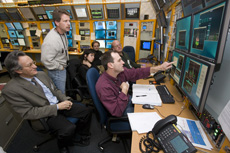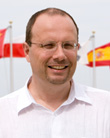|
Wednesday, Jan. 9
10:30 a.m. - noon
Lecture - WH8XO
Speaker: Sergy Kulagin INR, Moscow
Title: Nuclear Effects in Electron and Neutrino Deep-Inelastic Scattering
3:30 p.m.
DIRECTOR'S COFFEE BREAK - 2nd Flr X-Over
4 p.m.
Fermilab Colloquium - One West
Speaker: C. Will, Washington University, St. Louis
Title: On the Unreasonable Effectiveness of Post-Newtonian Theory in Gravitational-Wave Physics
Thursday, Jan. 10
9 a.m. - 6 p.m.
U.S. CMS "JTerm II workshop" -
One West
1 p.m.
Physics and Detector Seminar - WH-10NW, West Wing
Speaker: A. Para, Fermilab
Title: Possible SiD Implementations of Dual Readout Calorimetry
1 p.m.
Lecture - WH8XO
Speaker: Anatoli Butkevich, INR, Moscow
Title: Nuclear Effects in Neutrino Quasi-elastic Scattering
THERE WILL BE NO THEORETICAL PHYSICS SEMINAR THIS WEEK
3:30 p.m.
DIRECTOR'S COFFEE BREAK - 2nd Flr X-Over
THERE WILL BE NO ACCELERATOR PHYSICS AND TECHNOLOGY SEMINAR TODAY
Click here for NALCAL,
a weekly calendar with links to additional information. |
Wednesday, Jan. 9
- Creamy mushroom chicken soup
- Cajun chicken ranch
- Chicken Wellington
- Parmesan baked pork chops
- Smoked turkey panini pesto mayo
- Assorted slice pizza
- Chicken alfredo fettucine
Wilson Hall Cafe Menu |
|
Wednesday, Jan. 9
Lunch
- Cheese fondue
- Marinated vegetable salad
- Fresh fruit plate
Thursday, Jan. 10
Dinner
- Shrimp chowder
- Filet mignon w/pinot noir sauce
- Potato dauphinos
- Steamed green beans
- Marzipan cake
Chez Leon Menu
Call x4598 to make your reservation. |
|
|
Crystal collimation group builds next-gen technology
 |
| Fermilab's Dean Still (far right) points out potential crystal channeling to Walter Scandale, CERN; Jerry Annala, FNAL; Valentina Previtaly, CERN;
Vincenzo Guidi, University of Ferrara, INFN; and Todd Johnson, FNAL.
|
Fermilab provided a site for an international collaboration to test ways to improve on the LHC's data-taking abilities. The collaboration is studying the effects of crystals in the Tevatron.
The successful meeting of a group of 37 scientists from around the globe occurred early last month. The two-day workshop on crystal collimation set the stage for a Memorandum of Understanding that solidifies funding and responsibilities between Fermilab and eight other institutions. The MOU is expected to be finalized by the end of the month.
Beam collimation is the process of scraping the halo of particles around the beam core. This process reduces halo particles that can mimic events and harm detectors and magnets. In crystal collimation, a bent channeling crystal the size of a piece of linguini is used to coherently direct halo particles to an absorber where they are collected, drastically increasing system efficiency.
"This collaboration is very important. When the LHC is upgraded, the beam intensity will be increased and we will need different types of material next to the beam," said AD's Dean Still.
While current collimation techniques involve the use of steel plates, such as in the Tevatron, the crystals hold the promise of improved collimation, something the scientists hope to use for the LHC.
The idea for using bent crystals to reduce the halo of particles around the beam originated from work of Nikolai Mokhov and his co-authors in 1991 at the SSC time. Crystal channeling was tested in convincing experiments in Russia, CERN and later at Fermilab by Dick Carrigan. It was then pegged for the LHC, the next big accelerator project.
The collaboration, which began in 2005 and is led by co-spokespersons Walter Scandale of CERN and Fermilab's Nikolai Mokhov, tests crystals in the Tevatron collider whenever they can. The recent workshop happened to coincide with beam time, allowing scientists to view the experiment data, a rare occurrence.
"Crystals then were very rudimentary, and now we have very advanced crystal technology. Efficiency has improved from 15 percent to 95 percent," said Scandale.
-- Rhianna Wisniewski
|
Science, technology research funding hit hard
From Champaign-Urbana News-Gazette, Jan. 6, 2008
Editor's note: The following commentary was written by Kevin Pitts, chair of the Fermilab Users Executive Committee.
On Dec. 21, The News-Gazette reported that the 2008 budget passed by Congress (and subsequently signed by President Bush) cut $52 million in funding for Fermi National Accelerator Laboratory in Batavia.
Fermilab is home to the world's highest energy particle accelerator and hosts more than 2,000 scientists from across the country and around the world performing research in high energy physics.
As a consequence of these budget cuts, Fermilab is now faced with laying off 10 percent of its work force, implementing mandatory furloughs and halting research and development on future experiments and accelerators.
This devastating blow to our nation's premier particle physics laboratory graphically illustrates the consequences of the overall funding situation for basic research and development in the United States.
Read more
See all related news stories here
|
Magnetic jewelry an overlooked danger
From Chicago Tribune,
Dec. 20, 2007
The federal government brands magnets in toys a deadly hazard to children because the tiny, powerful objects can fall out and cause serious, even fatal, internal injuries when swallowed.
...The Tribune asked Joe DiMarco, an engineering physicist at the Fermi National Accelerator Laboratory in Batavia, to test the magnetic earrings as well as the type of Magnetix toys blamed for the death of Kenny Sweet on Thanksgiving Day 2005.
The tests showed the magnets from a Magnetix toy had a flux index of just above 50. The tests of the magnetic earrings showed a flux index on all of them above 50, and most were above 100 -- more than twice as powerful as the Magnetix...
Read More
|
|
|
Strong and steady
Today's column is written by Lothar Bauerdick, director of the CMS Center at Fermilab.
 |
| Lothar Bauerdick |
A new year is upon us - a very important startup year for CMS. For the first time, we will observe proton collisions in CMS at energies an order of magnitude higher than the world's current energy frontier, the Tevatron. We are poised to discover how nature works at the most fundamental level and hope to catch a glimpse before the end of the year.
The past year was one of great achievement and progress for CMS. Most of the detector elements have been lowered and put together in the experimental hall, and the world's biggest silicon strip tracker was installed in December.
CERN reopened on Monday following two weeks of rest and relaxation during the holidays. With renewed vigor we will begin our final push into the last stretch -- the last few months of intense preparation before the first data taking run.
The news about the budget decisions in Washington, D.C. has us concerned about the FY2008 budget's impact on the CMS experiment. Fermilab and the U.S. are enormously important for CMS. A third of the collaborators are at U.S. institutions and Fermilab is the largest CMS institute outside of CERN. The budget crisis comes at a time when CMS needs our full strength to finish preparations in order for data taking to be ready for the first beam.
The LHC program must continue at the full pace. With a lab-wide furlough at Fermilab, the CMS teams will work fewer days between now and the LHC startup expected later this year. We will need additional help to complete the remaining work on detector installation and commissioning, development of software, integration of computing systems and more, so we can be ready for data taking and for the first physics measurements.
We will need to keep the momentum here at Fermilab and at CERN, continuing to operate with full energy and optimism, safely and with our best efficiency and productivity. Fermilab will continue to be a strong and reliable partner.
The outlook is exciting. Fermilab is a crucial part of the new era of particle physics at the LHC!
|
ES&H weekly report, Jan. 8
This week's safety report, compiled by the Fermilab ES&H section, lists one recordable DART injury. The full report is here.
Safety report archive
|
|
Have a safe day!
Project X physics workshop Jan. 25-26
Fermilab will host a second users' workshop Jan. 25-26 to discuss the physics of Project X. The workshop will focus on the details of the experiments that might be proposed to take advantage of a high-intensity proton source, their physics impact
and the development of the overall experimental strategy. Information about the
workshop, working groups and ongoing efforts is available online.
Neutrino Department physics discussion Jan. 10
There will be two Neutrino department physics discussions this week. On Wednesday, Jan. 9, from 10:30 a.m.-noon in WH8XO, Sergei Kulagin from INR, Moscow will give a talk titled "Nuclear Effects in Electron and Neutrino Deep-Inelastic Scattering." On Thursday, Jan. 10, from 1-2 p.m. in WH8XO, Anatoli Butkevich from INR, Moscow will give a talk titled "Nuclear Effects in Neutrino Quasi-elastic Scattering."
New location for International Services
The Visa Office and Assignment Services have joined the User's Office to form International Services. The office has moved to the first floor of Wilson Hall on the west side. The contact information is as follows: Amanda Petersen, x4203; Barb Book, x3111; Melissa Clayton Lang, x3933; and John Galvan, x3811. The mail stop is MS 103 and the fax is x3688.
LPC Jterm-II workshop Jan. 10-12
The LHC Physics Center at Fermilab will sponsor a workshop titled "Jterm - II" from Jan. 10-12. The workshop is named for the January term at LPC and is for graduate students and postdocs between semesters. The two-day workshop will include plenary talks and tutorials. For more information or to register, visit the workshop Web site. To register, click the evaluation button at the top of the Web site's agenda page.
EAP Office relocation
The Employee Assistance Program Office has relocated to the first office on the West side of the 15th floor. To contact the EAP Office, please call Brian Malinowski at x3591 or e-mail.
The EAP is available 24/7 by calling (800) 843-1327.
Additional Activities
|
|